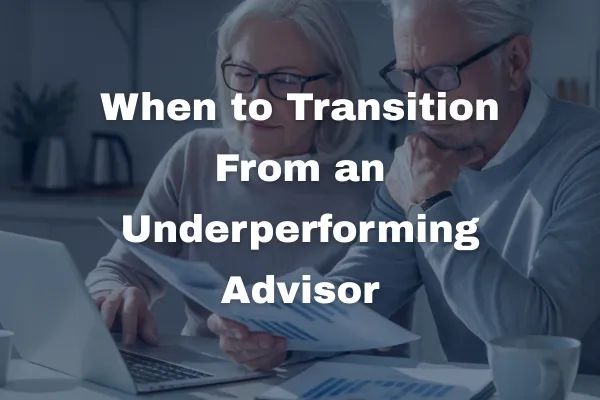
When to Transition From an Underperforming Advisor With Professional Discipline
When it's Time and How to Transition Advisors
(How to make a high-stakes change without emotion or regret)
“Accountability is the cornerstone of a successful investor relationship” - Paul Powell
Ending a relationship with a financial advisor is rarely easy.
It’s emotional, often delayed, and complicated by years of personal rapport.
But when the relationship no longer serves its purpose, maintaining it out of comfort can quietly cost years of progress.
Institutions face this same dilemma. They’ve learned to manage it with process and structure rather than emotion—a practice they call performance review and reallocation.
That same discipline can guide individual investors as well.

1. The Emotional Cost of Loyalty
We all value loyalty. It feels good to stay with people we trust.
But in finance, loyalty can sometimes turn into inertia — that quiet feeling of “I don’t want to deal with this right now.”
Institutions look at relationships differently. They view advisors as stewards of capital.
When results fall short or goals start to drift, they review performance, compare outcomes, and make a change if the data says it’s time.
It’s not personal. It’s process.
The key idea here is simple: accountability isn’t betrayal — it’s stewardship.
Reframing the decision from emotional to professional helps you protect your financial future without guilt or second-guessing.
2. The Three Triggers for Transition
3. Replace Emotion with Evidence
Before you make any decisions, gather the facts.
Here’s where institutions are methodical — and where you can be too:
Pull your written performance reports for the past year.
Compare your results to a benchmark you both agreed on.
Make a note of any gaps — missed updates, lack of follow-through, or broken communication.
Write down what was actually completed and what wasn’t.
If you realize those reports don’t even exist — that alone is meaningful data.
Data calms emotion. When you see it on paper, you move from “I feel” to “I know.”
4. Conduct an Exit Review — Not a Confrontation
Here’s something I learned in institutional management: professionals don’t “fire” advisors — they simply reallocate the relationship based on performance.
You can do the same thing.
When the time comes, the conversation should be short, structured, and focused on the facts.
You’re not defending yourself, and you’re not attacking them. You’re asking for understanding.
One question can change everything:
“Based on our original goals, how do these results compare to expectations?”
If the answer is clear and backed by data — that’s accountability.
If it’s emotional or defensive — that’s your sign.
Accountability handled with structure removes the need for conflict.
5. Selecting the Next Advisor
Once you’ve made your decision, don’t rush into the next one.
The best time to evaluate a new advisor is before you’ve officially moved on.
That’s where the Evidence-Based Hiring™ process comes in.
Verify expertise — don’t just trust experience.
Get transparency in writing, especially on fees and incentives.
Ask how results will be measured and tracked.
Make sure their definition of success matches yours.
Starting the next relationship with structure prevents you from repeating old mistakes.
Conclusion:
Every advisory relationship has a lifecycle. Some last decades. Others reach their natural end.
The mistake isn’t ending one — it’s staying too long after it stops working.
Professional discipline doesn’t erase trust; it protects it.
When you replace emotion with evidence, clarity replaces conflict — and confidence follows.
That’s what institutions understand.
And it’s how you can manage your own advisor relationship with the same professionalism and peace of mind.
Next Step: Access the Full Framework
Download “Financial Self-Defense”
The complete 27-question checklist that helps you apply the Evidence-Based Hiring™ process with institutional rigor.